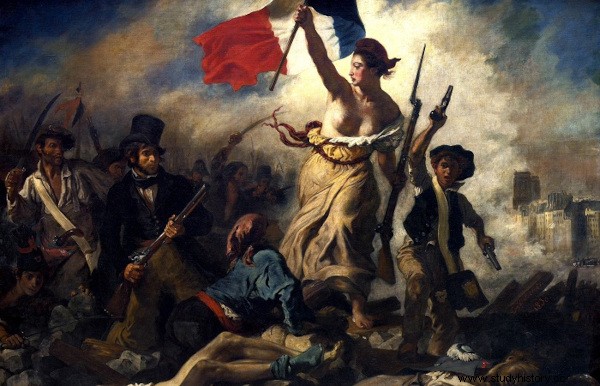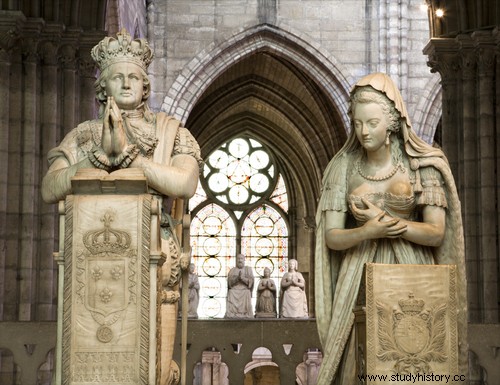The French Revolution , which took place in 1789, was the event that, according to some authors, inaugurated the so-called Contemporary Age . The historians of the 19th century, who made the dividing line in History, attributed to this event the character of a divider mark between the Modern and Contemporary Ages , due to the political radicalization that characterized it.
To understand the French Revolution it is necessary to know a little about the economic and social situation of France in the 18th century.
Also read: English Revolution – the first of the great bourgeois revolutions
Historical Background to the French Revolution
Until the 18th century, France was a state in which followed the model of monarchical absolutism . The then French king, Louis XVI, personified the State, bringing together the legislative, executive and judicial powers in his person. The French then were not citizens of a Constitutional Democratic State, as is common throughout the western world today, but they were subjects of the king.
Within the framework of the Absolutist State, there were three different states that the population fell into:
-
First State :was represented by the bishops of the High Clergy;
-
Second State :had as representatives the nobility, or the French aristocracy - who performed military functions (nobility of sword ) or legal functions (nobility in robes );
-
Third State :in turn, it was represented by the bourgeoisie, which was divided between members of the Lower Clergy, merchants, bankers, businessmen, the sans-cullotes (“without shorts”), urban workers and peasants, totaling about 97% of the population.
During the second half of the 18th century, France was involved in numerous wars , such as the Seven Years' War (1756-1763), against England, and the aid given to the United States in the War of Independence (1776). At the same time, the French absolutist Court, which had a high cost of living, was financed by the State, which, in turn, was already spending its budget on the bureaucracy that kept it running.
Add to this atmosphere two crises that France would have to face:
1) a crisis in the countryside , due to the bad harvests of the 1770s and 1780s, which generated 62% inflation; and
2) a financial crisis , derived from the public debt that was accumulating, mainly due to the lack of economic modernization – mainly the lack of investment in the industrial sector.
The members of the Third Estate (many of them influenced by Enlightenment thinking and the pamphlets that propagated the ideas of liberty and equality, disseminated among the population) became the most affected by the crisis.
Causes of the French Revolution
In the late 1780s, the bourgeoisie, urban workers and peasants began to demand a response from the King and Court to the crisis that affected them, as well as they began to demand rights broader and greater representation within the French political structure.
In July 1788, there was the convocation of the States General , that is, a meeting for deliberation on matters related to the political situation in France. In this call, the conflict between the interests of the Third Estate and those of the nobility and high clergy, who supported the king, intensified.
The king then established the Assembly of the Estates General on May 5, 1789, with the aim of deciding by vote the course of the country . However, the votes were for State representation. Therefore, the result would always be two votes against one, that is:First and Second States against the Third. A fact that aroused the indignation of bourgeois and workers.
The bourgeoisie, which led the Third Estate, proposed on June 10 a National Assembly , that is, an assembly to formulate a new Constitution for France. This proposal was not answered by the king, the nobility and the high clergy. On June 17, bourgeois, workers and other members of the Third Estate declared themselves in a meeting for the formulation of a Constitution, even without the response of the First and Second States. At the same time, a popular uprising began in Paris and another among the peasants . The Revolution has begun .
To learn more about these facts, read the text:Causes of the French Revolution.
Stages of the French Revolution

-
National Constituent Assembly
On July 14, 1789, the mass of people took the Bastille , the prison that was a symbol of the Ancien Régime, and on August 4, the National Assembly instituted a series of decrees that, among other things, cut off the privileges of the nobility, such as tax exemptions and the monopoly over arable land.
The Assembly instituted the Declaration of the Rights of Man and Citizen , which claimed the status of French citizens and no longer subjects of the king. In September 1791, the new French Constitution was promulgated , ensuring citizenship for all and pressuring the monarch Louis XVI to accept its criteria. This Constitution also provided:
-
the equality of all before the law,
-
the census vote,
-
the confiscation of ecclesiastical lands,
-
the end of tithing,
-
the civil constitution of the clergy, among other things.
From that moment, revolutionary France drafted its first type of new government, the Constitutional Monarchy , which lasted from 1791 to 1792.
-
Convention
The most radical wing of the Revolution, the Jacobins (who had participated in the Constituent Assembly, sitting on the left of the plenary and opposing the Girondins who were positioned on the right), defended an expansion of the revolutionary perspective, whose proposal was not to submit to the decisions of the high bourgeoisie, which articulated with the nobility and the monarch. The Jacobins wanted to radicalize the pressure against the nobles and the clergy , and institute a Revolutionary Republic, without any vestige of the Monarchy.
Foreseeing the threat that came from the directions the Revolution was taking,King Louis XVI articulated a counterrevolutionary uprising with the support of the Austrian and Prussian monarchies. In 1792, Austria invaded France and France declared war on France. The Parisian population, after learning of the king's plans, invaded the royal palace of Tulleries and arrested the king and his family. The r Hey and his wife Marie Antoinette had their heads cut off by the guillotine in 1793, and the Constitutional Monarchy came to an end in the same year.

With the end of the Constitutional Monarchy, there was also the dissolution of the Constituent Assembly and the National Convention of a new parliament. The Convention Period was characterized by the strong presence of Jacobin radicalism commanding the Revolution, a moment that became known as the Phase of Terror (especially due to the indiscriminate use of the guillotine as a death machine).
Names like Robespierre, Saint-Just and Danton are among the main Jacobin leaders. It was also during this period that Austria and Prussia continued their war against France, fearing that the Revolution would spread throughout their territories.
In the process of confrontation against these two monarchies, the French National Army was born , that is, an army that, for the first time, was not composed of mercenaries and aristocrats, but of the people who saw themselves as a nation.
-
Directory
In 1795, the bourgeoisie managed to regain power and, through a new Constitution, to institute a new phase to the Revolution, called the Directory , a body composed of five members appointed by the deputies. But from that same year the social crisis became very widespread in France , which required a more effective political contour, under penalty of the return of Jacobin radicalization.
Napoleon Bonaparte, one of the youngest and most outstanding generals of the Revolution, was the name expected by the bourgeoisie to bring order to the French political situation. In 1799, upon returning from Egypt to France, Napoleon encountered a conspiratorial scenario against the government of the Directory.
It was in this scenario that he started to appear as a dictator, initially, giving the Brumário Coup (according to the revolutionary calendar), and then as Emperor of France. The Napoleonic Period lasted from 1800 to 1815 and changed the political landscape of the European continent, while expanding the nationalist ideal to various regions of the world.
